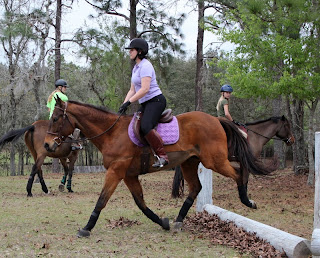 |
| Don't look down. |
Since Tank’s lips were still too sore for a bit, when I rode
him this weekend I used only my halter and lead rope. Since I had no reins with
which to communicate, I had to use my eyes, seat and legs to tell Tank where to
go and how fast. Notice I said “eyes”—with or without a bridle, one of the
rules of riding is to look where you want
to go. Sounds simple, right? It is, in theory, but it’s awfully easy to
find yourself looking down at the horse, or at the ground, or even in another
direction than the way you really want to go. The horse gets conflicting
signals and probably doesn’t go anywhere at all.
Remarkably like life, wouldn’t you say? We need to focus our
attention on the direction in which we want to travel. Don’t look at obstacles,
but beyond them to our chosen destinations. Don’t look backwards, because
that’s not where we’re going. Focus on what we want rather than what we don’t want, because according to Peter Jones
in How to Do Everything and Be Happy,
“It simply isn’t possible to not focus
on something. The very act of NOT thinking about something requires your brain
to conjure up images of the thing you don’t want to think about, so you can
ignore it. The only way not to focus on the wrong thing is to switch your focus
to something else.”
What are some things you’d like to focus on?








.jpg)


